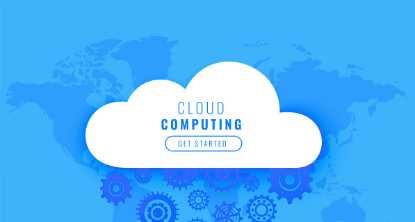Cloud computing has emerged as a game-changer in the field of information technology, revolutionizing the way businesses and individuals access and utilize computing resources. Cloud computing refers to the delivery of on-demand computing services, including storage, processing power, and software applications, over the internet. In this blog post, we will explore the transformative power of cloud computing, its benefits for organizations and individuals, and the future implications it holds for the IT industry.
The Transformative Power of Cloud Computing
Scalability and Flexibility: Cloud computing offers unparalleled scalability and flexibility. Organizations can easily scale their computing resources up or down based on demand, without the need for extensive hardware investments. This allows businesses to quickly adapt to changing requirements, handle peak workloads efficiently, and optimize resource utilization, leading to cost savings and improved operational efficiency.
Cost Efficiency: Cloud computing eliminates the need for upfront infrastructure investments and ongoing maintenance costs. Instead of investing in expensive hardware and software, organizations can subscribe to cloud services on a pay-as-you-go basis. This cost model allows businesses to reduce capital expenditure, optimize resource allocation, and allocate more resources to core business functions.
Accessibility and Collaboration: Cloud computing enables seamless access to data and applications from anywhere, at any time, using any device with an internet connection. This accessibility promotes collaboration among teams, even in geographically dispersed locations, fostering innovation, productivity, and efficient communication.
Data Security and Disaster Recovery: Cloud service providers prioritize data security and employ advanced security measures, such as encryption and access controls, to protect sensitive information. Additionally, cloud computing enables organizations to implement robust disaster recovery strategies by automatically backing up data and ensuring business continuity in the event of a system failure or natural disaster.
Benefits for Organizations and Individuals
Increased Efficiency: Cloud computing allows organizations to focus on their core competencies while leaving infrastructure management to the cloud service provider. This eliminates the need for extensive IT maintenance, updates, and troubleshooting, enabling IT teams to concentrate on strategic initiatives and innovation.
Enhanced Collaboration and Productivity: Cloud-based collaboration tools and applications facilitate seamless teamwork, document sharing, and real-time communication, improving productivity and efficiency across departments and teams.
Access to Advanced Technologies: Cloud computing provides access to cutting-edge technologies, such as artificial intelligence (AI), machine learning (ML), and big data analytics, which were previously limited to large enterprises with significant IT budgets. Small and medium-sized businesses can now leverage these technologies to gain insights, automate processes, and make data-driven decisions.
Cost Savings: By shifting from traditional on-premises infrastructure to cloud-based services, organizations can reduce costs associated with hardware procurement, maintenance, power consumption, and cooling. The pay-as-you-go pricing model ensures that businesses only pay for the resources they use, optimizing cost efficiency.
Future Implications for the IT Industry
Continued Innovation: Cloud computing is driving continuous innovation in the IT industry. As technology evolves, cloud service providers will continue to develop new services and solutions, such as serverless computing, edge computing, and hybrid cloud architectures, to meet the evolving needs of organizations.
Internet of Things (IoT) Integration: The integration of cloud computing with IoT devices will enable seamless data collection, analysis, and storage. Cloud platforms will serve as the backbone for managing the vast amounts of data generated by IoT devices, facilitating real-time decision-making and enabling new IoT applications.
Artificial Intelligence and Machine Learning: Cloud computing provides the computational power and storage capabilities required for AI and ML algorithms. Cloud-based AI platforms will democratize access to AI technologies, allowing organizations of all sizes to leverage the power of AI to improve operations, customer experiences, and innovation.
Edge Computing: The rise of edge computing , which brings computing resources closer to the data source, is set to transform the capabilities of cloud computing. By processing data at the edge of the network, closer to where it is generated, edge computing reduces latency and improves real-time data processing. This enables time-sensitive applications, such as autonomous vehicles, industrial automation, and smart cities, to operate with minimal delays and enhanced efficiency.
Security and Privacy Enhancements: As cloud computing continues to evolve, there will be a focus on improving security and privacy measures. Cloud service providers will invest in advanced encryption techniques, threat detection systems, and compliance frameworks to address emerging security challenges. Privacy regulations, such as the General Data Protection Regulation (GDPR), will influence how cloud providers handle and protect personal data, ensuring stronger data privacy for individuals and organizations.
Green Computing: Cloud computing has the potential to contribute to environmental sustainability by reducing energy consumption and carbon emissions. With the shift from on-premises infrastructure to cloud-based services, organizations can take advantage of the cloud provider's energy-efficient data centers. Cloud providers are also increasingly investing in renewable energy sources to power their data centers, further reducing the carbon footprint associated with IT operations.
Conclusion
Cloud computing has transformed the IT landscape, offering organizations and individuals a flexible, cost-effective, and scalable solution for accessing computing resources. The benefits of cloud computing, including increased efficiency, enhanced collaboration, and improved data security, have reshaped how businesses operate and innovate. As cloud technology continues to advance, the integration of IoT, AI, and edge computing will further amplify its impact on various industries.




Leave Comment